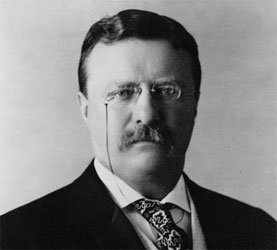NEW FEATURE: Celebrity Diagnoses in History

Today we begin a new feature of Celebrity Diagnosis. From time to time we will go back in history and discuss the illnesses that affected the health of celebrities past. Although the celebrities may be gone, the diseases they had are still with us, affecting the lives of many today. They are still “teachable moments in medicine.”
Our first entry is our 26th President, Theodore Roosevelt. Born in 1858, TR had early problems with severe asthma attacks. In his autobiography, TR wrote: “I was a sickly, delicate boy who suffered much from asthma, and frequently had to be taken away on trips to find a place where I could breathe.” Several kinds of medication were tried, the most effective being caffeine in a cup of strong coffee - which helped his breathing, but kept him awake. He also inhaled the fumes of stramonium, found in jimsonweed - which acted as a bronchodilator (a drug which opens up the airways). Encouraged by his father, TR was determined to overcome his sickly childhood and to build up his body. He took up boxing, wrestling, calisthenics, and mountain climbing - even climbing to the top of the Matterhorn in Switzerland! In the Spanish American War he led a small regiment in Cuba known as the “Rough Riders” and earned himself a Medal of Honor. During his presidency he would do strenuous exercise for two hours every day. In his post-presidency days he was an avid hunter, going on safaris in South America and Africa.
Asthma is a chronic disease of the lungs which affects 22 million Americans. Of these, nearly 6 million are children. Asthma causes recurrent episodes of wheezing (a whistling sound with breathing), chest tightness,shortness of breath, and coughing. The coughing often occurs at night or early in the morning. The symptoms of asthma are caused by narrowing of the airways, making it more difficult to get air into the lungs. There are two components that contribute to the narrowing of the airways: tightening of the muscles that surround the airway walls, and swelling of the lining of the airways. The swelling is an inflammatory response by the body which also produces an increased amount of mucus in the airways.

Figure A shows the location of the lungs and airways in the body. Figure B shows a cross-section of a normal airway. Figure C shows a cross-section of an airway during asthma symptoms. (Source: NHLBI)
There are many triggers for asthma, the most common of which include:
- Upper respiratory infections like colds and flu
- Exposure to allergens, such as dust, animal dander, mold
- Exercise
- Stress and strong emotions
- Inhalation of irritating substances such as smoke, aerosols. air pollution
- Cold temperatures
- Gastroesophageal reflux (a condition where stomach acids back up into the esophagus)
There is no cure for asthma, although some with childhood asthma will seem to outgrow it. Treatment is both preventive (limiting exposures to known triggers, using anti-inflammatory medications) and episodic- both oral and/or inhaled medications to relax airway muscles.
Asthma is a large subject. Future blog entries will touch on other aspects of the disease and its treatment.
For more information:
| Resounding Health(tm) Asthma |
Advertisement
[AMAZONPRODUCT=0071476520] [AMAZONPRODUCT=0767912896] [AMAZONPRODUCT=0764137859] [AMAZONPRODUCT=0471441163]
























0 comments